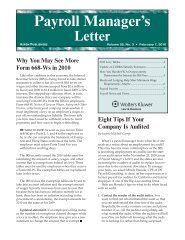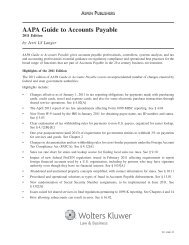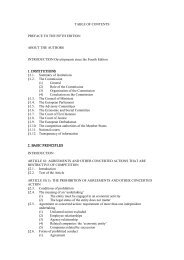journal of pension planning & compliance - Kluwer Law International
journal of pension planning & compliance - Kluwer Law International
journal of pension planning & compliance - Kluwer Law International
Create successful ePaper yourself
Turn your PDF publications into a flip-book with our unique Google optimized e-Paper software.
WILL THE PENSION PROTECTION ACT PROTECT DEFINED BENEFIT PENSIONS? / 3<br />
THE EVOLUTION OF THE PBGC: HOW WE GOT HERE<br />
When the Pension Benefits Guaranty Corporation (PBGC) was<br />
created in 1974, there was an urgency to get the agency staffed and operating.<br />
The procedures and policies needed to be enacted quickly. Based<br />
on a nonscientific sampling <strong>of</strong> a few annuities, the PBGC’s actuaries<br />
put together a set <strong>of</strong> tables that insured <strong>pension</strong> plans were required to<br />
implement. The tables were peculiar in that they reflected an inverted<br />
yield curve and were heavily loaded in favor <strong>of</strong> the insurer (Lucas and<br />
Furdek, 2008). This was beneficial for the <strong>pension</strong>ers when the <strong>pension</strong><br />
plans were amply funded. When interest rates were comparatively high<br />
and the economy was in a growth mode, most firms were adequately<br />
funding their <strong>pension</strong> obligations.<br />
Many key factors changed when major firms began to outsource<br />
production and faced international competition in their markets. One<br />
factor was that a significant number <strong>of</strong> firms were falling behind in<br />
funding <strong>pension</strong>s partly due to falling interest rates and opted to pay<br />
higher premiums. Coupled with Chapter 11 bankruptcies <strong>of</strong> large companies,<br />
namely LTV Steel and United Airlines, the PBGC found itself<br />
in a serious financial situation and began to run chronic deficits. Following<br />
the resolution <strong>of</strong> a conflict with the Internal Revenue Service,<br />
the PBGC changed its methodology for evaluating <strong>pension</strong> obligations,<br />
utilizing 30-year Treasury Security yields to evaluate <strong>pension</strong> liabilities.<br />
This reduced obligations for <strong>pension</strong> funds briefly, but with a slowing<br />
economy and even lower interest rates, <strong>pension</strong> funds continued to lag<br />
in the financial obligation to fully fund <strong>pension</strong>s.<br />
Realizing that many <strong>pension</strong> plans were in jeopardy with inadequate<br />
financial backing, coupled with the precarious financial<br />
situation at the PBGC, Congress passed the PPA with the intent <strong>of</strong><br />
providing the PBGC with a solid financial foundation as well as insuring<br />
adequate funding to protect defined benefit <strong>pension</strong> plans. One feature<br />
<strong>of</strong> the PPA was a reconstitution <strong>of</strong> the method that firms would<br />
determine the value <strong>of</strong> <strong>pension</strong> assets and to establish the value <strong>of</strong> the<br />
<strong>pension</strong> obligation. The U.S. Treasury would publish three rates each<br />
month that firms would use to determine the value <strong>of</strong> assets and three<br />
different rates to determine the value <strong>of</strong> the <strong>pension</strong> obligation. The<br />
difference would be used to determine the cost <strong>of</strong> the insurance premium.<br />
The intent <strong>of</strong> the three rates, one rate for obligations over years<br />
1 through 5, another for years 6 through 20, and a third for 21 or more<br />
years into the future, was to represent more accurately the yield curve<br />
<strong>of</strong> a blend <strong>of</strong> AA bonds and U.S. Treasury securities. The purpose <strong>of</strong><br />
these requirements on <strong>pension</strong> plans was to insure adequate funding<br />
for the PBGC and to provide a better financial foundation for existing<br />
<strong>pension</strong> plans.






